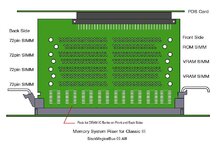alectrona2988
Well-known member
Well this went more ambitious than I thought. The idea of redesigning the board would be great!
What about using the FPU "slot" (and guides for support) for a 4 SIMM "SIMM saver" turned 90°? FYI, I brought a bunch of dual / angled 30pin PCB SIMM holders (metal clip) a la the SE ones back from the US for @max1zzz. If those were used with 16Mb SIMMs, that'd get you to 64Mb...
I guess it depends on the price-point you're aiming at... what about 16M (or maybe 64M on the 'board and a expansion slot card for additional?I am however kind of inclined to just solder 64 or 128mb of memory direct to the board
Well i'm still kinda mixed, I would prefer slots but SIMM sockets can be somewhat hard to find (At least in the UK thy are, they are somewhat easyier to get in the US but that means buying through a proxy for me...)@max1zzz whatcha thinking now?
And if going that route, open up possibilities re. chip densities... 2 x 64k x 4, 8 x 64k x 1, 2 (rows) of 8 x 32k x 1, etc... (I'm no expert on the available combos)or could just have the DRAM soldered to it
Take it further? I've always wondered about voltage leveling for running more modern 3.3V ICs or higher capacity modules? Memory/PDS Riser setup allows for all kinds of prototyping on both fronts. PCB size and footprint of board is flexible if limited for running inside the bucket, but risers ca be oversize for running a large prototyping system. The CPU/Ports board need never be removed for access to the two subsystems on the riser.And if going that route, open up possibilities re. chip densities...
You're on the right track, but lack of LCIII built in video subsystem would be the problem you'd face.... maybe adapting the SE/30 design and streamlining it to be more akin to the Classic II would be a good idea.

